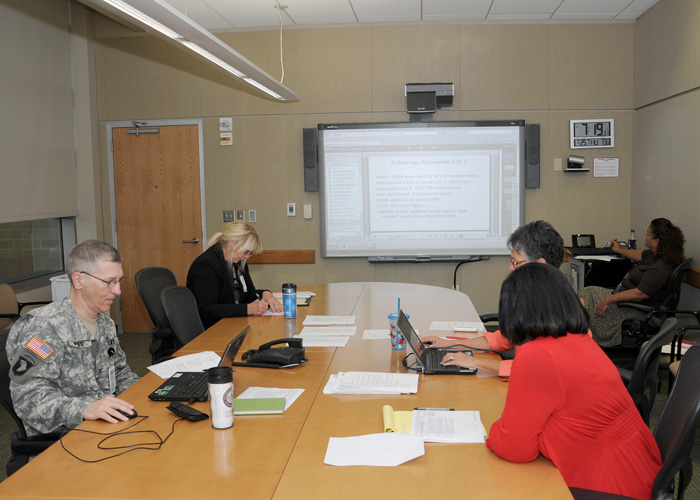JTS Designated DoD Center of Excellence

The Joint Trauma System at the U.S. Army Institute of Surgical Research at Joint Base San Antonio'Fort Sam Houston was designated as a Department of Defense Center of Excellence for Trauma by the Office of the Assistant Secretary of Defense June 19. In a memorandum from the OASD, the Center of Excellence Oversight Board (chartered by OASD to provide oversight to all DCoEs and determine which centers meet the criteria of a DCoE) thoroughly reviewed the JTS concept of operations and determined it met the criteria of a DCoE.
"The JTS is a global organization committed to the health and welfare of combat wounded," said Mary Ann Spott, JTS Deputy Director and inaugural director. "We oversee the performance improvement and the follow-through of the performance improvement on all casualties of war to optimize the survivability and decrease the morbidity and mortality of all wounded warriors."
Established in 2006 at the direction of the Assistant Secretary of Defense for Health Affairs and the Service Surgeon General to improve trauma care for combat wounded, the JTS has collected data from more than 130,000 combat casualty care records from Iraq and Afghanistan. With this type of data, the JTS staff has created 39 clinical practice guidelines to provide evidence-based best-practice recommendations for trauma care.
"The advancements made in trauma and combat casualty care during the recent conflicts in Iraq and Afghanistan have in large part resulted from the continuous JTS operational cycle of data collection, data analysis, and resultant formulation and adaptation of best evidence-based practice guidelines," said Col. (Dr.) Jeffrey A. Bailey, JTS Director. "The designation of the JTS as a Defense Center of Excellence derives from its past record of performance and its future promise as the lead agent for DoD trauma care and trauma systems."
"Clearly, the Joint Trauma System has shown the military health system the potential that an integrated battlefield trauma system can deliver," said Maj. Gen. (Dr.) Douglas J. Robb, Deputy Director, TRICARE Management Activity, who was the Joint Staff Surgeon at the Pentagon when the JTS was designated a DCoE. "The operational model of continuous collection of trauma care delivery data via the DoD trauma registry with continuous data analysis driving performance improvement via best practice guidelines has no doubt delivered as evidenced by our current conflict's lowest lethality rate ever recorded."
Before the establishment of the JTS, the Joint Theater Trauma System and the Joint Theater Trauma Registry had been established in 2004 in Iraq to improve hospital-based care for combat wounded. At the same time, data were being collected at Landstuhl Regional Medical Center in Germany and the USAISR, with each location using different data storage computer programs and neither having any formal data analysis procedures.
"There were some good-faith efforts by a lot of people, but they were disjointed," Spott said.
In 2005, Spott was hired as a consultant at the USAISR to evaluate data collection and analysis, and to present a recommendation for the way forward.
"There was an effort at a data collection system, but there was no process improvement system, data analysis, or education system," she said.
Spott's recommendation for the JTS was to start over.
"We started formalizing procedures and processes, started the network, bringing people together and getting the documentation together, and hiring the right people," she said.
Within a year, the existing group of 25 staff members grew to 80 to include surgeons, a physician, nurses, medical coders, medical analysts, and information specialists.
"The DCoE is a validation for this process," said Col. (Dr.) Kirby Gross, Division Director for Performance Improvement and Education and Interim JTS Director. "In addition to the validation as a DCoE, we were validated in 2011 by being funded not on contingency basis but on a POM [Program Objective Memorandum—long-term funding]."
Kirby added that part of the reason for the success of the JTS is that staff members deploy to the JTTS.
"We have one foot in theater and one foot here," he said.
"The rotational and programmed Joint Trauma System director deployments to theater as the combatant commander Joint Theater Trauma System director gives the JTS first-person familiarity with kinetically active combined joined operational areas," said Bailey, the current U.S. Central Command JTTS Director. "This actualizes the link between the JTS and the US COCOM Joint Theater Trauma Systems and provides a unique and critical perspective on current theater conditions, anticipated changes, and potential opportunities for improvement in combat casualty care."
"We are very proud to have achieved this milestone," said Col. (Dr.) Michael A. Weber, USAISR commander. "General Caravalho [USAMRMC commander, Maj. Gen. (Dr.) Joseph Caravalho Jr.] and I applaud the efforts of the JTS staff members for their commitment to our mission of optimizing combat casualty care, and their dedication and perseverance to improve care to our wounded warriors."
"Being designated a Center of Excellence will be a challenge for us," said Kirby. "It will provide higher visibility for the JTS and the ISR. The team here is a very experienced team. They are committed to the mission and they recognize that the products of their efforts have made an impact on the battlefield."
The USAISR is a subordinate command of the U.S. Army Medical Research and Materiel Command. The mission to "optimize combat casualty care" is accomplished by conducting science and clinical research in the fields of damage control resuscitation, hemostasis, engineering, and tissue regeneration affecting combat casualties, to include burns.














